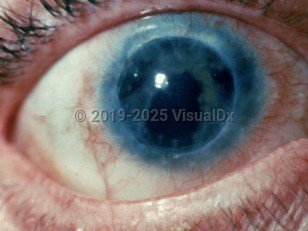Ocular syphilis - External and Internal Eye
Alerts and Notices
Important News & Links
Synopsis

Syphilis crisis in the United States: Syphilis and congenital syphilis cases have been surging nationwide, with an 80% increase in total syphilis cases between 2018 and 2022. Serologic testing is the primary means of diagnosing, staging, and managing syphilis. Testing should be done for any sexually active patient in whom syphilis is suspected or who has new, unexplained symptoms. Prompt diagnosis and treatment of syphilis can prevent systemic complications, including ocular involvement and permanent blindness.
Syphilis is a sexually transmitted infection (STI) caused by the bacterium Treponema pallidum (a spirochete) and is characterized by a chronic, intermittent clinical course. Treponema pallidum is transmitted person to person via mucous membranes or through direct contact with a syphilis ulcer during vaginal, anal, or oral sex.
There are 4 main stages of syphilis: primary, secondary, latent, and tertiary. Active infection stages include primary, secondary, and early latency. Tertiary syphilis has a later onset in patients who never received initial treatment. Tertiary syphilis can include cardiac or neurologic manifestations known as neurosyphilis.
Syphilitic uveitis or other ocular syphilis manifestations (eg, neuroretinitis and optic neuritis) can occur at any stage of syphilis, including early-stage syphilis, and can be isolated abnormalities or associated with neurosyphilis.
All structures of the eye may be involved by syphilis, which is why it has been named the great imitator. Manifestations can include conjunctivitis, scleritis, episcleritis, keratitis, glaucoma, ocular motility disturbances, ptosis, pupillary changes, lens dislocation, uveitis, vitritis, chorioretinitis, or optic atrophy. Patients may present with vision changes (eg, vision blurring or dimming, impaired color perception, photophobia) and decreased visual acuity that can progress to permanent blindness. In one-half of cases, both eyes are affected. Some ocular manifestations may occur years after initial involvement.
Ocular syphilis can be congenital or acquired. Congenital syphilis, despite its relative rarity, still poses a very significant threat to the eye.
If ocular syphilis is suspected, immediate referral to and management in collaboration with an ophthalmologist is crucial. Ocular syphilis should be treated similarly to neurosyphilis, even if a cerebrospinal fluid (CSF) examination is normal.
Prognosis is variable and depends on at what stage the disease was treated and what ocular structures have been affected. Anterior uveitis and retinal vasculitis usually have good prognoses. Poorer prognostic factors include coinfection with HIV, associated optic neuropathy, or poor vision at the time of diagnosis.
Related topics: early and late congenital syphilis, primary syphilis, secondary syphilis, neurosyphilis
Syphilis is a sexually transmitted infection (STI) caused by the bacterium Treponema pallidum (a spirochete) and is characterized by a chronic, intermittent clinical course. Treponema pallidum is transmitted person to person via mucous membranes or through direct contact with a syphilis ulcer during vaginal, anal, or oral sex.
There are 4 main stages of syphilis: primary, secondary, latent, and tertiary. Active infection stages include primary, secondary, and early latency. Tertiary syphilis has a later onset in patients who never received initial treatment. Tertiary syphilis can include cardiac or neurologic manifestations known as neurosyphilis.
Syphilitic uveitis or other ocular syphilis manifestations (eg, neuroretinitis and optic neuritis) can occur at any stage of syphilis, including early-stage syphilis, and can be isolated abnormalities or associated with neurosyphilis.
All structures of the eye may be involved by syphilis, which is why it has been named the great imitator. Manifestations can include conjunctivitis, scleritis, episcleritis, keratitis, glaucoma, ocular motility disturbances, ptosis, pupillary changes, lens dislocation, uveitis, vitritis, chorioretinitis, or optic atrophy. Patients may present with vision changes (eg, vision blurring or dimming, impaired color perception, photophobia) and decreased visual acuity that can progress to permanent blindness. In one-half of cases, both eyes are affected. Some ocular manifestations may occur years after initial involvement.
Ocular syphilis can be congenital or acquired. Congenital syphilis, despite its relative rarity, still poses a very significant threat to the eye.
If ocular syphilis is suspected, immediate referral to and management in collaboration with an ophthalmologist is crucial. Ocular syphilis should be treated similarly to neurosyphilis, even if a cerebrospinal fluid (CSF) examination is normal.
Prognosis is variable and depends on at what stage the disease was treated and what ocular structures have been affected. Anterior uveitis and retinal vasculitis usually have good prognoses. Poorer prognostic factors include coinfection with HIV, associated optic neuropathy, or poor vision at the time of diagnosis.
Related topics: early and late congenital syphilis, primary syphilis, secondary syphilis, neurosyphilis
Codes
ICD10CM:
A51.43 – Secondary syphilitic oculopathy
SNOMEDCT:
410478005 – Ocular syphilis
A51.43 – Secondary syphilitic oculopathy
SNOMEDCT:
410478005 – Ocular syphilis
Look For
Subscription Required
Diagnostic Pearls
Subscription Required
Differential Diagnosis & Pitfalls

To perform a comparison, select diagnoses from the classic differential
Subscription Required
Best Tests
Subscription Required
Management Pearls
Subscription Required
Therapy
Subscription Required
References
Subscription Required
Last Reviewed:09/23/2021
Last Updated:04/03/2024
Last Updated:04/03/2024
Ocular syphilis - External and Internal Eye

